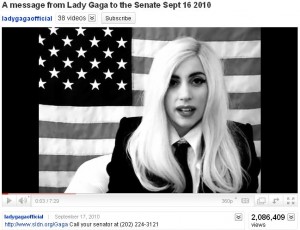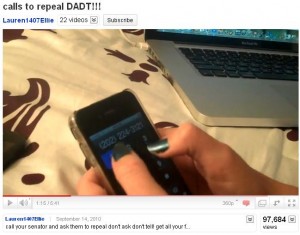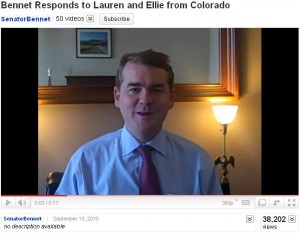You know something has had an impact on you when you're still thinking about it weeks after the fact. And what happened recently on YouTube got me thinking.
Members of Congress and their staffs have gotten used to a world where a constituent writes a postal letter or e-mail or calls the office and the office responds in written form to the citizen's concerns. One of the challenges that social media creates for congressional offices is that they can no longer just wait for constituent communication to come to them. They now need to monitor external sources to capture it all.
As Congresswoman Cathy McMorris-Rodgers said in our 'Inside the Hill' web series, 'the world has changed.'
What punctuated this for me was the flurry of activity around a Senate vote regarding the military's 'Don't Ask, Don't Tell' (DADT) policy. Regardless of what side of this sensitive social issue you come down on, something happened that should be instructive to Members of Congress, advocacy organizations, and citizens alike.
The Service members Legal Defense Network (SLDN) is an organization dedicated to ending DADT. They recently enlisted Lady Gaga, of…well…Lady Gaga fame, to create and post a YouTube video asking her considerable fan base to call their Senators to request an end to the ban on openly gay service members. This video is interesting from a number of perspectives, not the least of which is that, when she calls her Senators live in the video, she never actually gets through to either one because the volume of calls to the Senate’s phone system resulted in a busy signal from one and an at-capacity mailbox from the other. What happens next is even more interesting.
In a dorm room in Boulder, Colorado, two college students named Ellie and Lauren decide to heed the advice of SLDN and Lady Gaga and contact their Senator, the junior Senator from Colorado, Michael Bennet. They don’t just pick up the phone though, they record a video of themselves calling the Senator’s office, much like Lady Gaga did in her video. At times laughing and a bit perplexed by the process—something they had clearly never done before—they ultimately left a voicemail message for Senator Bennet on September 14.
The following day, September 15, Senator Bennet was quick to respond to Ellie and Lauren with a short, 17-second video assuring them that he supports the repeal of DADT. While Senator Bennet is not the first Member to record a YouTube response directly to a constituent, the speed with which the Senator responded seems to illustrate a change that is taking place on Capitol Hill. Members are starting to become more adept at using social media tools to engage in a genuine two-way dialogue with constituents.
What does this mean for Congress and the citizen advocates that want to participate in the policy making process?
Implications for Congressional Offices:
- Social media tools like YouTube, Twitter, and Facebook can allow you to reach constituents that you might not otherwise reach. This may have been the only way that Senator Bennet would have had contact with these two Colorado residents.
- I can hear staffers groaning (I know, I was one) at the thought of trying to pin down their bosses and get them to record messages back to constituents on YouTube. It will no doubt be challenging, but the Bennet video took 17 seconds to record. Most Members’ schedules can accommodate the creation of a couple of videos each week or month.
- The best way to encourage your boss to engage in social media is to demonstrate the impact it can have. At the writing of this post the Bennet video had been viewed more than 38,000 times!
Implications for Grassroots Advocates:
- While tempting, this outcome cannot be replicated for every one of your campaigns and for every Member of Congress. The best thing you can do is determine the best avenue of communications for each and every one of the 541 Members of Congress. If Members like Rep. Culberson and Sen. McCaskill are prolific users of Twitter (and they are), then maybe you use Twitter. If there are Members who haven’t yet embraced social media (and there are) a YouTube campaign will be much less effective.
- Not everyone has Lady Gaga on their side, but is there someone who has the ear of a lot of other someones that you could enlist in your efforts?
- As the Lady Gaga video illustrates, if the message to your supporters is “call your Senator” and the Senate’s phone system is overloaded (something our friends in the Office of the Senate Sergeant at Arms assures us is being upgraded to better accommodate higher volumes of calls) then your advocates will be frustrated with both you and their Members. Be more strategic in how you suggest that your members contact their elected officials.





